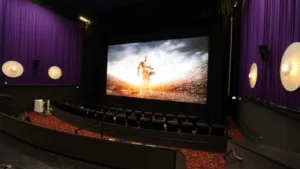
There was no question about the Samsung story going on the front page. I regularly talk about ‘inflection points’. Cinema is at one this week.
At Infocomm in 2015, one of the LED suppliers told me that it had been asked to quote a price for a cinema display using LED, but the price had been too high. However, as you will see from Chris’s article, Samsung thinks that it can compete with high end projection and, given the deal already done for the media block, it has clearly been working on this project for some time.
Chris spoke to some who saw the demo and said that the general view of the image quality was ‘excellent’. I have also done some digging around among those lucky enough to have seen it. The feedback was, again, that they were impressed, especially with the contrast and vibrant colours. The demos showed lots of detail in the shadows, but without a side by side reference, it was unclear if any further detail was being lost. There was also some concern of whether the display might be a bit too bright for a fully darkened room. On the other hand, the sunlight looked ‘natural’ and that is quite an achievement!
Of course, Samsung will have to compete with NEC, Barco, Christie and Sony in the cinema market. As Chris has said, Sony was caught by surprise by the announcement and I suspect this also applies to the others. One of the unknown questions is colour gamut and the competition for LED will be from RGB laser projectors which have very pure primaries and can get to (or extremely close to) the very difficult Rec. 2020 gamut. It would be surprising if Samsung could get to that level of gamut with today’s LEDs. In the longer term, using LEDs with QDs for colour conversion might get closer to the performance of lasers.
Cinema enthusiasts always look for ‘film-like’ experiences and dislike, for example, high frame rates. Personally, I like HFR. but I note that Samsung is specifying 60fps as the maximum. That’s not really surprising, with this kind of digital display, there is always a trade-off between bit depths and frame rates and this kind of display is going to need a good bit depth to ensure that banding and other artefacts are not visible, given the HDR performance.
However, overall, I have been saying since I saw the issues with reflected light in cinema and the impact that it has by reducing the maximum system contrast for projection in HDR, that projection might come under attack from a technology that could deliver really high contrast, regardless, or almost regardless, of the ambient conditions.
The projector makers all have LED businesses of different strengths and scale. It’s less obvious that Samsung has any fundamental advantages in the cinema market other than its overall scale and technology strength. It’s discrete LED display business is still in its early phases and has gone more slowly than some of its management hoped. Although the projection suppliers have competed in cinema projection, I suspect that the competition has probably been marginally less fierce than in some of the markets that we track. However, Samsung will, no doubt aim to be top very quickly.
There will be a lot to learn about how the LEDs will perform in practice. I found myself, the other day, fascinated by how many bad pixels there were in a perimeter display at a recent soccer match. Of course, they may have been from a bad brand and have probably been physically abused, but failed pixels will not be very acceptable in the cinema!
Bob

